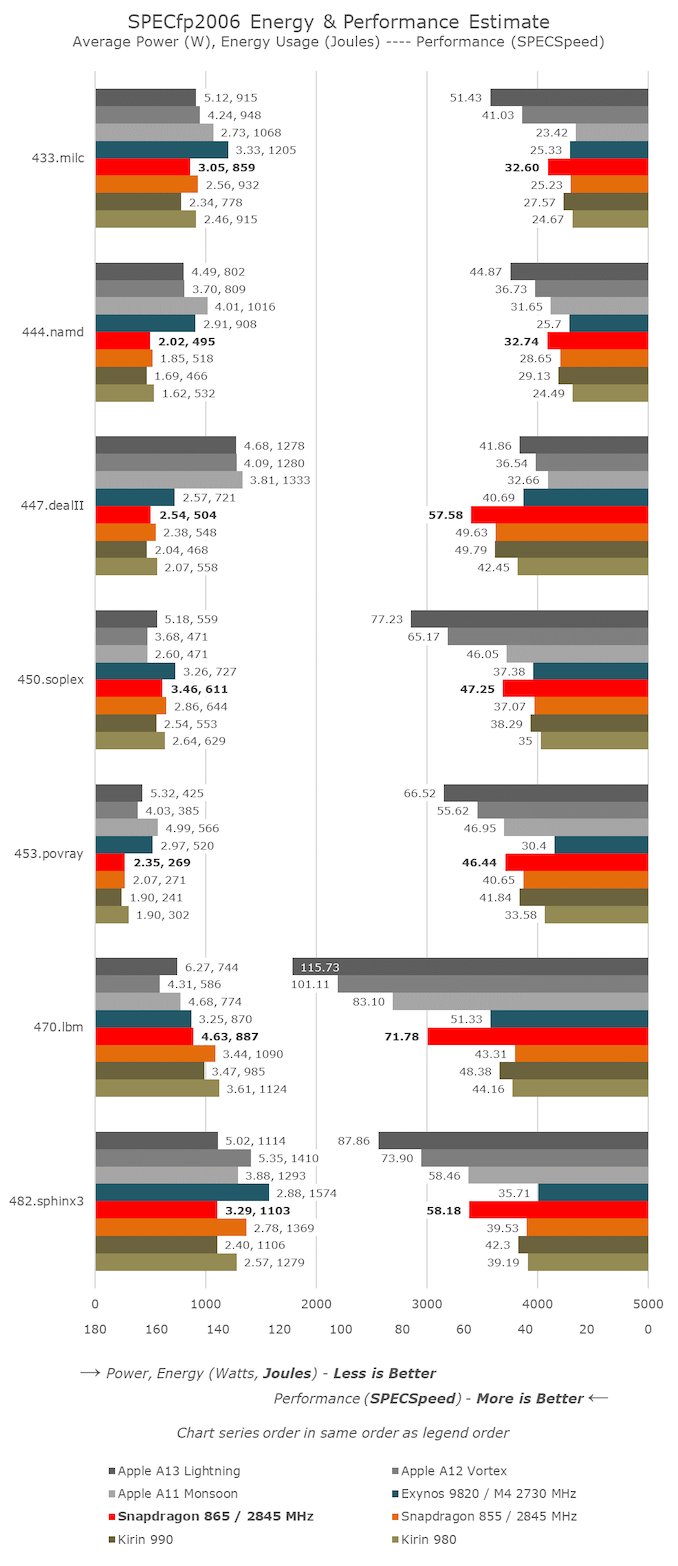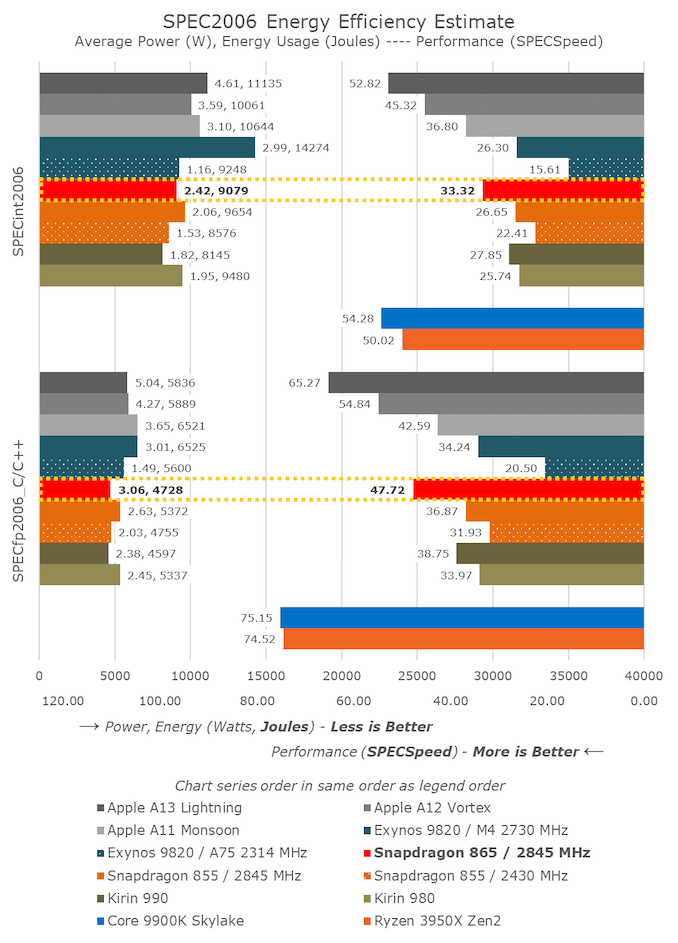The Snapdragon 865 Performance Preview: Setting the Stage for Flagship Android 2020
by Andrei Frumusanu on December 16, 2019 7:30 AM EST- Posted in
- Mobile
- Qualcomm
- Smartphones
- 5G
- Cortex A77
- Snapdragon 865
CPU Performance & Efficiency: SPEC2006
We’re moving on to SPEC2006, analysing the new single-threaded performance of the new Cortex-A77 cores. As the new CPU is running at the same clock as the A76-derived design of the Snapdragon 855, any improvements we’ll be seeing today are likely due to the IPC improvements of the core, the doubled L3 cache, as well as the enhancements to the memory controllers and memory subsystem of the chip.
Disclaimer About Power Figures Today:
The power figures presented today were captured using the same methodology we generally use on commercial devices, however this year we’ve noted a large discrepancy between figures reported by the QRD865’s fuel-gauge and the actual power consumption of the device. Generally, we’ve noted that there’s a discrepancy factor of roughly 3x. We’ve reached out to Qualcomm and they confirmed in a very quick testing that there’s a discrepancy of >2.5x. Furthermore, the QRD865 phones this year again suffered from excessive idle power figures of >1.3W.
I’ve attempted to compensate the data as best I could, however the figures published today are merely preliminary and of lower confidence than usual. For what it’s worth, last year, the QRD855 data was within 5% of the commercial phones’ measurements. We’ll be naturally re-testing everything once we get our hands on final commercial devices.
In the SPECint2006 suite, we’re seeing some noticeable performance improvements across the board, with some benchmarks posting some larger than expected increases. The biggest improvements are seen in the memory intensive workloads. 429.mcf is DRAM latency bound and sees a massive improvement of up to 46% compared to the Snapdragon 855.
What’s interesting to see is that some execution bound benchmarks such as 456.hmmer seeing a 28% upgrade. The A77 has an added 4th ALU which represents a 33% throughput increase in simple integer operations, which I don’t doubt is a major reason for the improvements seen here.
The improvements aren’t across the board, with 400.perlbench in particular seeing even a slight degradation for some reason. 403.gcc also saw a smaller 12% increase – it’s likely these benchmarks are bound by other aspects of the microarchitecture.
The power consumption and energy efficiency, if the numbers are correct, roughly match our expectations of the microarchitecture. Power has gone up with performance, but because of the higher performance and smaller runtime of the workloads, energy usage has remained roughly flat. Actually in several tests it’s actually improved in terms of efficiency when compared to the Snapdragon 855, but we’ll have to wait on commercial devices in order to make some definitive conclusions here.
In the SPECfp2006 suite, we’re seeing also seeing some very varied improvements. The biggest change happened to 470.lbm which has a very big hot loop and is memory bandwidth hungry. I think the A77’s new MOP-cache here would help a lot in regards to the instruction throughput, and the improved memory subsystem makes the massive 65% performance jump possible.
Arm actually had advertised IPC improvements of ~25% and ~35% for the int and FP suite of SPEC2006. On the int side, we’re indeed hitting 25% on the Snapdragon 865, compared to the S855, however on the FP side we’re a bit short as the increase falls in at around 29%. The performance increases here strongly depend on the SoC and particular on the memory subsystem, compared to the Kirin 990’s A76 implementation the increases here are only 20% and 24%, but HiSilicon’s chip also has a stronger memory subsystem which allows it to gain quite more performance over the A76’s in the S855.
The overall results for SPEC2006 are very good for the Snapdragon 865. Performance is exactly where Qualcomm advertised it would land at, and we’re seeing a 25% increase in SPECint2006 and a 29% in SPECfp2006. On the integer side, the A77 still trails Apple’s Monsoon cores in the A11, but the new Arm design now has been able to trounce it in the FP suite. We’re still a bit far away from the microarchitectures catching up to Apple’s latest designs, but if Arm keeps up this 25-30% yearly improvement rate, we should be getting there in a few more iterations.
The power and energy efficiency figures, again, taken with a grain of salt, are also very much in line with expectations. Power has slightly increased with performance this generation, however due to the performance increase, energy efficiency has remained relatively flat, or has even seen a slight improvement.














178 Comments
View All Comments
yankeeDDL - Tuesday, December 17, 2019 - link
No, I was looking at the Web benchmarks. All of them are miserable compared even to the iPhone X.And Web browsing is certainly a key part of mobile experience.
joms_us - Tuesday, December 17, 2019 - link
And yet in real world comparison, iPhone is faster only in handful of sites (excluding apple.com LOL) by millisec. Does that look miserable to you? =DNicon0s - Tuesday, December 17, 2019 - link
Yes and have you actually seen an Android flagship that performs noticeably worse than an iphone(any iphone) in web browsing? Because I sure haven't.What I have seen is Android phones with better connection speed and better reception in general, especial in crowded places like concerts, stadiums, subways etc. In those places the performance from the iphone x was actually 0 in many instances because there was no signal. If we are talking about the mobile experience let's not ignore the Modem.
s.yu - Tuesday, December 17, 2019 - link
"If we are talking about the mobile experience let's not ignore the Modem."And there are connectivity tests for that, although controlling variables in a connectivity test is almost impossible outside of lab conditions.
Ultimately these are separate tests and test entirely different aspects. You're free to test both, but if you try to test them simultaneously outputting one single result, you will obtain one worthless data point.
Wilco1 - Tuesday, December 17, 2019 - link
Synthetic browsing benchmarks depend highly on software implementation and tuning, so they are not useful to compare CPU performance.yeeeeman - Tuesday, December 17, 2019 - link
A bit MEH...Alistair - Tuesday, December 17, 2019 - link
The Android fanatics are out tonight. I only buy Android phones, period. Clearly Apple's CPUs are miles ahead in performance. Anyone use the latest iPad Pro? It's faster than any Windows laptop I've bought or used personally. Boss gave us the latest and greatest dual core HP ultra slim laptop, and I immediately replaced it with a Ryzen 8 core computer and said "I don't use laptops for real work". We don't need benchmarks to tell us how fast Apple's CPUs are (though Andrei's benchmarks are perfectly valid), it is immediately apparent when comparing vs. similarly clocked Intel products. The reasons Ryzen and Intel seem great right now are high clocks and many cores. Run your 9900k in 2 core mode, at 2.6 Ghz and squirm at its low speed. That's what the iPhone uses, a low clocked dual core. Put 8 together, and run it at 4 Ghz, and you have a monster.id4andrei - Tuesday, December 17, 2019 - link
You're forgetting a stripped down mobile OS and relatively stripped down mobile apps that are part of the speed equation.Alistair - Tuesday, December 17, 2019 - link
that has nothing to do with it, that's what I'm saying, that's what Andrei is sayingAlistair - Tuesday, December 17, 2019 - link
the other Andrei lol